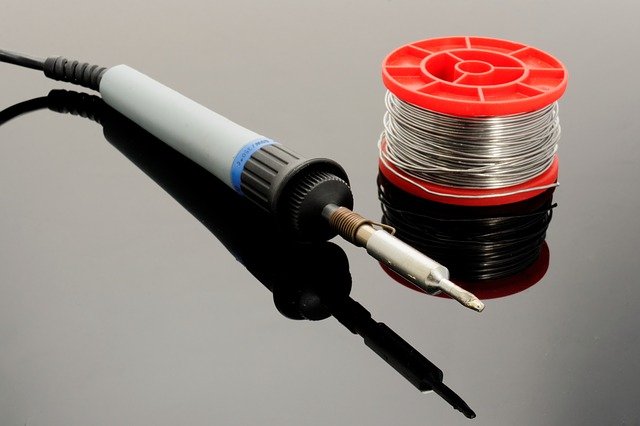Soldering
Contents |
[edit] Introduction
Soldering is a method of permanently joining or seaming together pieces of metal. It can be used to repair small holes in metal, assemble electronic components, join pipes and so on.
[edit] Three elements of soldering
The soldering process involves three main elements - heat, filler (or solder) and flux.
[edit] Heat
Heat is generally created by a soldering iron or blowtorch. The most common types of soldering irons are electrically powered, although there are some that can be heated in a fire. A propane blowtorch tends to be more effective at heating thick metal quickly. In some instances, a hot air gun can be used for soft soldering projects while a furnace can be used in hard soldering to heat the components until the solder melts.
There are other industrial soldering methods, including:
- Electrical resistance soldering using tungsten or copper electrodes.
- Induction soldering using high frequency alternating current.
- Ultrasonic soldering using ultrasonic vibrations transmitted by a nickel rod through the solder.
[edit] Filler materials
These are special alloys known as solder. Solder is available as rods, wires, strips, sheets or other forms. The type of solder used in the process must have a melting point that is lower than that of the metals being joined.
Soft solder is usually a mixture of lead and tin. Soft solder tends to use heat from a soldering iron or blowtorch. Soft solder is typically used for joining elements such as copper plumbing fittings.
Hard solders generally incorporate brass solders (such as copper-zinc alloys), silver solders, copper solders, nickel-silver solders, solders for light alloys and so on. Hard solder also uses heat from a soldering iron or blowtorch, but it can also use other sources of heat (such as a furnace).
[edit] Flux
Flux creates a chemical barrier to prevent the formation of oxides (which can impede the bonding process). There is liquid flux (referred to as corrosive or active flux) that must be washed away from the surface once the solder hardens and becomes solid. There is also passive flux, which is a paste that cannot be washed away entirely. Therefore, this method is primarily used for purposes (such as electrical connections or copper plumbing joints) where it can do a sufficient job of excluding oxide without requiring it to be dissolved entirely.
Some types of wire solder incorporate flux into their core.
[edit] Combinations of metal, solder and flux
Some of the most commonly found combinations of materials used in the standard soldering process are:
| Types of metal | Types of solder | Types of flux |
| Silver, brass, copper, nickel | Silver solder | borax cone ground up and mixed with water in a borax dish. |
| Gold | Gold solder | borax cone ground up and mixed with water in a borax dish. |
| Cast iron | Brazing solder (see below) | special flux from copper (or cuprous) oxide. |
[edit] Brazing
Brazing is a method of hard soldering that involves a copper-zinc alloy as the filler material and borax as the flux. Brazing requires extremely high temperatures (much higher than those created through soft soldering techniques).
Dip brazing is a technique in which metal is immersed in the molten jointing medium. It is widely used in industrial mass-production processes.
[edit] Related articles on Designing Buildings
Featured articles and news
A change to adoptive architecture
Effects of global weather warming on architectural detailing, material choice and human interaction.
How big is the problem and what can we do to mitigate the effects?
Overheating guidance and tools for building designers
A number of cool guides to help with the heat.
The UK's Modern Industrial Strategy: A 10 year plan
Previous consultation criticism, current key elements and general support with some persisting reservations.
Building Safety Regulator reforms
New roles, new staff and a new fast track service pave the way for a single construction regulator.
Architectural Technologist CPDs and Communications
CIAT CPD… and how you can do it!
Cooling centres and cool spaces
Managing extreme heat in cities by directing the public to places for heat stress relief and water sources.
Winter gardens: A brief history and warm variations
Extending the season with glass in different forms and terms.
Restoring Great Yarmouth's Winter Gardens
Transforming one of the least sustainable constructions imaginable.
Construction Skills Mission Board launch sector drive
Newly formed government and industry collaboration set strategy for recruiting an additional 100,000 construction workers a year.
New Architects Code comes into effect in September 2025
ARB Architects Code of Conduct and Practice available with ongoing consultation regarding guidance.
Welsh Skills Body (Medr) launches ambitious plan
The new skills body brings together funding and regulation of tertiary education and research for the devolved nation.
Paul Gandy FCIOB announced as next CIOB President
Former Tilbury Douglas CEO takes helm.
UK Infrastructure: A 10 Year Strategy. In brief with reactions
With the National Infrastructure and Service Transformation Authority (NISTA).
Ebenezer Howard: inventor of the garden city. Book review.
Airtightness Topic Guide BSRIA TG 27/2025
Explaining the basics of airtightness, what it is, why it's important, when it's required and how it's carried out.






















